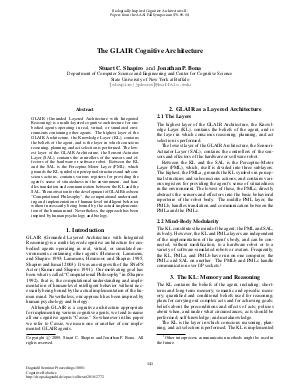The GLAIR Cognitive Architecture
Authors Stuart C. Shapiro, Jonathan P. Bona
-
Part of:
Volume:
Dagstuhl Seminar Proceedings, Volume 10081
Part of: Series: Dagstuhl Seminar Proceedings (DagSemProc) - License:
 Creative Commons Attribution 4.0 International license
Creative Commons Attribution 4.0 International license
- Publication Date: 2010-10-27
File

PDF
DagSemProc.10081.17.pdf
- Filesize: 0.87 MB
- 12 pages
Document Identifiers
Subject Classification
Keywords
- Cognitive Robotics
- Cognitive Architectures
- Embodiment
- Situatedness
- Symbol Grounding
Metrics
- Access Statistics
-
Total Accesses (updated on a weekly basis)
0Document
0Metadata
Abstract
GLAIR (Grounded Layered Architecture with Integrated Reasoning) is a multi-layered cognitive architecture for embodied agents operating in real, virtual, or simulated environments containing other agents. The highest layer of the GLAIR Architecture, the Knowledge Layer (KL), contains the beliefs of the agent, and is the layer in which conscious reasoning, planning, and act selection is performed. The lowest layer of the GLAIR Architecture, the Sensori-Actuator Layer (SAL), contains the controllers of the sensors and effectors of the hardware or software robot. Between the KL and the SAL is the Perceptuo-Motor Layer (PML), which grounds the KL symbols in perceptual structures and subconscious actions, contains various registers for providing the agent’s sense of situatedness in the environment, and handles translation and communication between the KL and the SAL. The motivation for the development of GLAIR has been “Computational Philosophy”, the computational understanding and implementation of human-level intelligent behavior without necessarily being bound by the actual implementation of the human mind. Nevertheless, the approach has been inspired by human psychology and biology.
Cite As Get BibTex
Stuart C. Shapiro and Jonathan P. Bona. The GLAIR Cognitive Architecture. In Cognitive Robotics. Dagstuhl Seminar Proceedings, Volume 10081, pp. 1-12, Schloss Dagstuhl – Leibniz-Zentrum für Informatik (2010)
https://doi.org/10.4230/DagSemProc.10081.17
BibTex
@InProceedings{shapiro_et_al:DagSemProc.10081.17,
author = {Shapiro, Stuart C. and Bona, Jonathan P.},
title = {{The GLAIR Cognitive Architecture}},
booktitle = {Cognitive Robotics},
pages = {1--12},
series = {Dagstuhl Seminar Proceedings (DagSemProc)},
ISSN = {1862-4405},
year = {2010},
volume = {10081},
editor = {Gerhard Lakemeyer and Hector J. Levesque and Fiora Pirri},
publisher = {Schloss Dagstuhl -- Leibniz-Zentrum f{\"u}r Informatik},
address = {Dagstuhl, Germany},
URL = {https://drops.dagstuhl.de/entities/document/10.4230/DagSemProc.10081.17},
URN = {urn:nbn:de:0030-drops-27724},
doi = {10.4230/DagSemProc.10081.17},
annote = {Keywords: Cognitive Robotics, Cognitive Architectures, Embodiment, Situatedness, Symbol Grounding}
}
